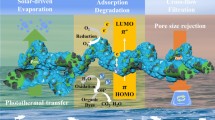Abstract
With the development of industry in recent years, the problem associated with water pollution has been aggravated, and so this causes serious damage to our environment. One of the most effective ways to improve water pollution is the use of the "titanium dioxide (TiO2) photocatalytic method". For this reason, we prepared TiO2 photocatalyst with silver (Ag) and graphene oxide (GO) by means of sol–gel method to obtain TiO2/Ag, TiO2/GO and TiO2/Ag/GO three photocatalysts. We then employed the visible light as light source, the methylene blue as pollutants, the UV–Visible absorption spectrometer measurement, and so compared the removal fraction of the three photocatalysts. Among them, the TiO2/Ag/GO photocatalyst has the highest dye removal fraction (51.41 ± 5.58%). The comparison of the TiO2/Ag/GO photocatalyst with the best efficiency was made with commercially available P25 photocatalyst to block the UV light. By referring to the experiments on the UV light block, the removal fraction of TiO2/Ag/GO photocatalyst (48.71 ± 2.02%) was higher than commercially available P25 photocatalyst (25.66 ± 3.66%). In this study, in order to efficiently recover the used photocatalyst, a photocatalyst blended solution was prepared with different weight percentages of TiO2/Ag/GO photocatalyst and nylon (Nylon 6,6)/formic acid solution (8wt%). To that end, the technology of electrospinning was used to produce a nanofiber membrane (TiO2/Ag/GO/Nylon 6,6 NFM). Based on the experimental results, the 3.0wt% TiO2/Ag/GO/Nylon 6,6 nanofiber membrane has the best visible light removal fraction of methylene blue (90.52 ± 0.58%).








Similar content being viewed by others
Data Availability
The datasets generated during and/or analysed during the current study are available from the corresponding author on reasonable request.
References
Alengebawy A, Abdelkhalek ST, Qureshi SR, Wang M-QJT (2021) Heavy metals and pesticides toxicity in agricultural soil and plants: Ecological risks and human health implications. Toxics 9(3):42. https://doi.org/10.3390/toxics9030042
Rajoria S, Vashishtha M, Sangal VK (2022) Treatment of electroplating industry wastewater: a review on the various techniques. Environ Sci Pollut Res. https://doi.org/10.1007/s11356-022-18643-y
Chen Y, Yu Q (2021) Research progress on degradation of VOCs by metal ions doped titanium dioxide nanoparticles. J Phys Conf Ser 2021(1):13–15. https://doi.org/10.1088/1742-6596/2021/1/012063
Nien Y-H, Liao J-L, Syu Z-J (2022) Preparation of Nanofibrous Membrane With rGO/TiO2 Photocatalyst and Its Application in Organic Degradation. IEEE Trans Nanotechnol 21:23–28. https://doi.org/10.1109/TNANO.2021.3139938
Song F, Sun H, Ma H, Gao HJN (2022) Porous TiO2/Carbon Dot Nanoflowers with Enhanced Surface Areas for Improving Photocatalytic Activity. Nanomaterials 12(15):2536. https://doi.org/10.3390/nano12152536
Zuo Y, Chen L, Zhu B, Gao Y (2018) Properties of Graphene Oxide Loaded by Nano-ZnO/Epoxy Resin Composites. J Mater Eng 46(5):22–28. https://doi.org/10.11868/j.issn.1001-4381.2016.000935
Lerf A, He H, Forster M, Klinowski J (1998) Structure of graphite oxide revisited. J Phys Chem B 102(23):4477–4482. https://doi.org/10.1021/jp9731821
Suwanchawalit C, Wongnawa S, Sriprang P, Meanha PJCI (2012) Enhancement of the photocatalytic performance of Ag-modified TiO2 photocatalyst under visible light. Ceram Int 38(6):5201–5207. https://doi.org/10.1016/j.ceramint.2012.03.027
Tauc J, Grigorovici R, Vancu A (1966) Optical properties and electronic structure of amorphous germanium. Physica Status Solidi B 15(2):627–637. https://doi.org/10.1002/pssb.19660150224
Tauc J (1972) Chapter 5 of Optical Properties of Solids. In: Abeles F (ed) North-Holland Publishing Company, ISBN:0720402042, Amsterdam
Author information
Authors and Affiliations
Corresponding author
Ethics declarations
Conflict of interest
The authors declare no conflict of interest.
Additional information
Publisher's note
Springer Nature remains neutral with regard to jurisdictional claims in published maps and institutional affiliations.
Rights and permissions
Springer Nature or its licensor (e.g. a society or other partner) holds exclusive rights to this article under a publishing agreement with the author(s) or other rightsholder(s); author self-archiving of the accepted manuscript version of this article is solely governed by the terms of such publishing agreement and applicable law.
About this article
Cite this article
Nien, YH., Huang, TY., Hsiao, CT. et al. Preparation of TiO2/Ag/GO/Nylon 6,6 nanofiber membrane by a novel electrospinning method and its photodegradation efficiency under visible light. J Polym Res 29, 518 (2022). https://doi.org/10.1007/s10965-022-03379-7
Received:
Accepted:
Published:
DOI: https://doi.org/10.1007/s10965-022-03379-7




